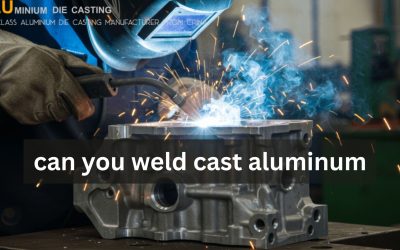Anodizing Cast Aluminum: Enhancing Capabilities of the Material
Surface treatment is core part of most metal manufacturing processes meant to counter the many elements that metal products come into contact with. Altering the physical, mechanical, and chemical properties of cast aluminum and other metals is sometimes necessary for aesthetic and functional value.
For cast aluminum products, anodizing surface finish is one of the commonest surface treatments. At our company, we have been anodizing die-cast aluminum for a wide range of customers and applications. The reports we get from the customers is a reiteration of our conviction that anodizing cast aluminum is valuable. if you are looking for ADC12 anodizing cast aluminum, A380 anodizing casting or any other anodizing die casting alloys, welcome to contact us.
In this article, we outline the process and explain why anodized cast aluminum is popular in the industries.
What is anodizing?
Anodizing involves a setup comprising a tank, power supply, work piece, dielectric fluid, and an electrode. This setup, when powered, triggers a chemical reaction that leads to the deposition of an oxide layer on the metal surface. The resulting layer is porous, so the manufacturer can decide to use secondary operations.
Most important, this layer wards off corrosion and wear, thus protecting the substrate. As can be deduced from this overview, anodizing is straightforward and inexpensive, hence its popularity.
What is Anodizing Cast Aluminum?
Anodizing cast aluminum is an electrochemical surface finish treatment used to enhance the surface properties of aluminum die castings. It involves forming a thick, durable oxide layer on the surface of the aluminum through an electrolytic reaction. This oxide layer improves the material’s corrosion resistance, wear resistance, and aesthetic appearance while maintaining the lightweight properties of aluminum. go to anodizing cast aluminum guide line page to know moare about this anodizing process.
Process of anodizing surface finish
There are several steps in anodizing cast aluminum as outlined next;
1. Cleaning and Preparation
It is important to prepare the surface of the cast aluminum before anodizing it. First, you need to clean the cast aluminum to remove any surface contaminants. A cleaner metal surface results in better adhesion of the surface treatment.
Next, we prepare the aluminum part or component for anodizing cast aluminum. At this stage, we may cover some, that is, if we are anodizing only some areas. Etching may also be necessary if we want the adhesion to be even more effective. Where there is potential for grease forming on the part surface, it is important to degrease the surface to remove related contaminants.
2. The Anodizing Process
To anodize the now-ready cast aluminum, the operator dips it into a solution of sulfuric acid electrolyte. This electrically conductive electrolyte contains numerous positive and negative ions. The setup comprises an anode, cathode, electrolyte in a container, and a power source.
The cast aluminum forms the anode while the cathode (carbon or any other suitable material) is on the other end. When a direct electric current passes through the circuit, electrons leave the surface of the cast aluminum. Consequently, positively charged aluminum ions form.
When the electrons leave the aluminum, they promote the formation of negatively charged oxygen ions. These oxygen ions immediately land on the cast aluminum surface and combine with the positive aluminum ions to form a layer of aluminum oxide.
 We can manipulate the thickness of the aluminum oxide layer through these parameters:
We can manipulate the thickness of the aluminum oxide layer through these parameters:
- The electrolyte concentration
- Time for the process
- Amount of current
- The temperature
There are various tests to tell when the anodizing cast aluminum process is complete, including the eddy current test, conductivity test, and scratch resistance test.
3. Finalizing the Anodizing Process
When we are certain the process is as per the specifications, we switch off the power and allow the part to cool. At this point, we can also apply a specific color or dye to the part.
It is also necessary to seal the anodized cast aluminum to maintain the new surface quality. The three most popular sealing techniques are chemical, water, and steam sealing.
Anodized Cast Aluminum for Enhanced Performance
The primary benefit of anodizing cast aluminum is enhanced performance through higher corrosion resistance. The thin layer of aluminum oxide has higher corrosion resistance than the original metal layer.
Increased wear resistance is also a big plus. While the hardness of cast aluminum is around HV100, anodizing cast aluminum takes the surface hardness to within HV300. With its porosity, this layer can easily adsorb surface lubricant for even higher wear resistance.
If a part requires excellent heat resistance and thermal insulation, anodized cast aluminum makes even more sense. The layer of anodized
aluminum presents better thermal insulation than the substrate. Anodized cast aluminum can operate normally under a temperature of up to 1500°C, but ordinary aluminum can barely reach 700°C.
Anodizing cat alumium and its Design Effects
Design improvements are another reason many clients ask for anodized cast aluminum. The uniform and attractive appearance of an anodized surface can add to the aesthetics of the part. A wide range of finishes are available, from clear anodizing aluminum to matte black anodized aluminum and many more. This surface finish can also introduce different colors and patterns, often to customization levels.
Anodized Cast Aluminum for Different Industries
Many industries continue to enjoy the benefits of anodizing cast aluminum. In the automotive industry, lightweight and corrosion-resistant parts are widely used. Engine parts and rims are only examples of components made from anodized cast aluminum. Such products enhance the fuel efficiency and longevity of the vehicle.
When cast aluminum is anodized, it also becomes more relevant in architectural projects. With the increased color options, added aesthetic value, and enhanced durability, anodized cast aluminum parts, facades, window frames, and many other structural components are more suitable for these demanding projects.
Challenges of Anodizing Cast Aluminum
Although anodizing cast aluminum have many advantages in the aluminum industry, it has some drawbacks relative to anodizing wrought aluminum. Different alloy compositions and structural properties of cast aluminum influence the anodizing process.
Below are some challenges for anodized aluminum casting products:
- High Silicon Content
To increase aluminum alloys castability, cast aluminum alloys sometimes feature high silicon (usually 7–12%) concentrations.
Under the anodizing process, silicon does not oxidize, producing a non-uniform oxide layer. This can produce instead of a clear, even look a dark, spotty, or blotchy finish.
- Porosity and Surface Defects
Aluminum parts created by die casting often show surface imperfections and internal porosity—air pockets. These pores can trap air or electrolyte solution during anodizing, producing an uneven finish and obvious blems.
- Inconsistent Color
A consistent color on anodized cast metal is challenging in presence of silicon and other contaminants. While colored anodizing could seem uneven, clear anodizing could produce a grayish or drab appearance.
Athough above points are only a few, but there are some more points effect to the quality of anodizing aluminum casting parts, but we have some good solution to anodize aluminum die casting products, this will be great cost reducing which can be used to replace the alumium CNC machining products.
Innovative Anodized Cast Aluminum Solutions
We can all agree that anodizing cast aluminum makes a lot of sense, but there is one more point. You need to do it with the right company. The process can be challenging and ineffective when done wrongly.
Our die casting company is an industry leader in providing innovative anodized cast aluminum solutions. We have redefined this space through impeccable customer service, the use of modern cast aluminum anodizing practices, and being environmentally conscious throughout the processes.
A key definition of our products and services is a focus on customer-relevant anodizing results. Our unmatched color combinations and customized surface finishes set us apart from the competition.
You can rest assured that our anodized cast aluminum products are of the highest quality because of our world-class quality assurance. To crown it all, our team closely attends to any specific aluminum anodizing requests.
If you are looking for anodizing die casting aluminum service, welcome to content us, we are die casting China manufacturer, offering die casting parts and post manufacturing, such as powder coating aluminum, anodizing aluminum, painting anodized aluminum, plating aluminum etc.






0 Comments